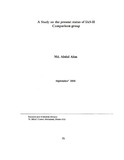A study on the present status of lAS-II comparison group
Date
2000-09Publisher
Research and Evaluation Division, BracAuthor
Alim, Md. AbdulMetadata
Show full item recordCitation
Alim, M. A. (2000). A study on the present status of lAS-II comparison group. RESEARCH REPORTS (2000), ECONOMIC STUDIES, (XV), 1–16.Abstract
The Research and Evaluation Division (RED) of BRAC has over the years been making efforts to
evaluate the impact of Rural Development Programme (RDP) on its members through impact
assessment studit:S (lASs). RED has already conducted two such evaluations : IAS-I and LAS-II. A Uurd
lAS is now underway. The panel comparison group, for L-\S , had been formed during lhe first lAS to
measure the effective impact of RDP interventions making comparison between Ulis group and RDP
beneficiaries group. The present report anempts to provide a few necessary inputs to LAS-III by
examining the present status of the comparison group that would be required for the study.
Although sdet;tion of t;Omparison household group is of vital necessity for impact assessment studies, it
has been found that impact srudies have been perennially pla.:,oued by the lack of availability of
appropriate non-beneficiaries. This is because NGO penetration has been pervasive. The reasons for this
are lbe phenomen.1l growth of micro credit and proliferation of NGOs.
The objective of the study was to examine the present status of IAS-ll comparison group .md find out
whether household members were stillli"ing in their villages and whether they were involved ~ith any
GO!NGO programmes as well as to look into the reasons for joining with these programmes.
The present report was based on a survey that was conducted on 239 comparison households spread in
10 upazilas and 10 districts. It showed that 95% (228) were still living in their respective villages which
meant that migr:ltion was quite low. The survey 3lso revealed the ex"lent of NGO membership status of
the comparison hous~!holds and found that 55% households were involved in various GO/NGO
development programmes since 1996. Almost half of the households out of 55 % were involved with
Grameen B:mk, 15% joined BRAC followed by Bangladesh Rural Development Board (BRDB),
Proshik.l, ASA tmd several other snuller NGOs. Data on lenoot.h of involvement of rhe members involved
in different GO/NGO programmes have pointed out certain defects in the selection of comparison group
for L~-II by showing that 21% of the membrn were already involved in GO/NGO programmes when
the lAS started. This weakness limited the impact assessment to some ex-tent. It was found that .t 1%
households did not join GO/NGO programmes. However, 29% out of these were earlier associated with
GOINGO programmes. Reasons that were cited by households who never joined GO/NGO programmes
indude worry and tension of these households fearing failure in n!pa:ying loan installments and lack of
scope for invesunent. Only ~<% households numbering ten were not found owing to migration to other
villages or cities in search of work or otl\er reasons to survive and 1% households heads died during the
period.
Methodology
Survey

